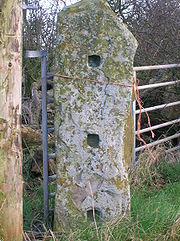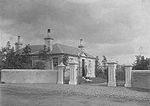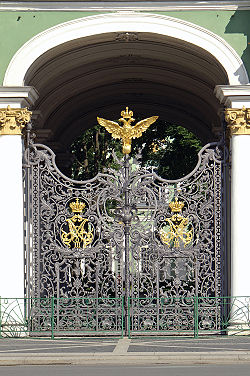
Gatepost
Encyclopedia
A gatepost is a structure used to support gate
s or crossbars which control entry to an area, such as a field or driveway.
 If the gatepost is utilitarian in purpose then gateposts will be made as strictly functional structures; however as part of the 'advertisement' of the status of the family who live beyond, they are often carefully designed and constructed and sometimes highly ornate or individualistic. Gateposts give an additional element of character to the countryside and conurbations, significantly they also play host a habitat for many lichen
If the gatepost is utilitarian in purpose then gateposts will be made as strictly functional structures; however as part of the 'advertisement' of the status of the family who live beyond, they are often carefully designed and constructed and sometimes highly ornate or individualistic. Gateposts give an additional element of character to the countryside and conurbations, significantly they also play host a habitat for many lichen
, moss
and liverwort
species.
, whinstone, sandstone
or limestone
. Occasionally standing stones have been moved and re-used as gateposts, especially on Dartmoor
and in Cornwall
. Bricks are frequently used and some are made from stones or small boulders, tending to be cylindrical in shape.

 These are a form of gate which permits people through or over an entrance but which blocks the passage of animals. Branches or worked wood crossbars were used, one field stile gatepost with 'L' shaped grooves and the opposing stile gatepost with square concavities to receive the three or four horizontal crossbars. Most of these have long been converted to carry hinged gates, though one survives unaltered at the Museum of Scottish Rural Life, Kittochside on Wester Kittochside farm, East Kilbride, Scotland. They were sometimes made entirely of wood, such as oak, which is relatively long lasting.
These are a form of gate which permits people through or over an entrance but which blocks the passage of animals. Branches or worked wood crossbars were used, one field stile gatepost with 'L' shaped grooves and the opposing stile gatepost with square concavities to receive the three or four horizontal crossbars. Most of these have long been converted to carry hinged gates, though one survives unaltered at the Museum of Scottish Rural Life, Kittochside on Wester Kittochside farm, East Kilbride, Scotland. They were sometimes made entirely of wood, such as oak, which is relatively long lasting.
The term 'Stoup' is used in Cumbria
and some examples are elaborately finished, with dates and initials and even whole names, sometimes with the sort of flowing script more usually found on gravestones. One example is dated as far back as 1663.
The shape of the stile gateposts is variable, mostly being oblong and square in section, however some were 'tombstone' shaped, having two flat sides and a curved top.

 Many houses have driveways of varying lengths and gateposts are a way of making a social statement of status, through the cost implications of an ornate or 'awe inspiring' entrance way.
Many houses have driveways of varying lengths and gateposts are a way of making a social statement of status, through the cost implications of an ornate or 'awe inspiring' entrance way.
Some entrances had two or even three gates attached to the gateposts, such as at Robertland House in East Ayrshire
, Scotland, the side gates being for the use of pedestrians. The gates themselves could be wood or more commonly cast iron
, wrought iron
or mild steel. A large number of the cast iron gates were removed by the Ministry of Works in World War II to be melted down and used to build weapons, etc. Once removed these gates were rarely replaced.
A sign of very high status was to have sufficient wealth to have gatehouses or lodges near the gates. Some estates had several lodges and the owners would at one time have employed people to live in these buildings and their jobs would be to open and close the gates, thereby controlling the movements of livestock and also of visitors, some of whom would be denied access or directed way from the front door to the tradesman's entrance.
The date of construction can often be deduced from the style, many being Victorian
, due to the wealth creation of the period and the number of large dwellings consequently constructed. Large balls, looking like finial
s are sometimes precariously perched on top of gateposts, as at Woodway House
in Teignmouth
, South Devon.
Many gateposts have been removed to allow for the access of larger modern farm machinery, sometimes only one has been moved and the other left in situ.
it is not too unusual to find curling
stones crowning a gatepost. Examples of gateposts with highly ornate railings are sometimes found outside new houses where they dominate the dwelling itself.
Gate
A gate is a point of entry to a space enclosed by walls, or a moderately sized opening in a fence. Gates may prevent or control entry or exit, or they may be merely decorative. Other terms for gate include yett and port...
s or crossbars which control entry to an area, such as a field or driveway.
Purpose

Lichen
Lichens are composite organisms consisting of a symbiotic organism composed of a fungus with a photosynthetic partner , usually either a green alga or cyanobacterium...
, moss
Moss
Mosses are small, soft plants that are typically 1–10 cm tall, though some species are much larger. They commonly grow close together in clumps or mats in damp or shady locations. They do not have flowers or seeds, and their simple leaves cover the thin wiry stems...
and liverwort
Marchantiophyta
The Marchantiophyta are a division of bryophyte plants commonly referred to as hepatics or liverworts. Like other bryophytes, they have a gametophyte-dominant life cycle, in which cells of the plant carry only a single set of genetic information....
species.
Construction materials
They are often made of wood, such as old railway sleepers, telegraph poles or even tree trunks. For a longer 'life' more resilient iron girders or pipes may be used and concrete posts are sometimes employed. The older examples were often made of stone, such as graniteGranite
Granite is a common and widely occurring type of intrusive, felsic, igneous rock. Granite usually has a medium- to coarse-grained texture. Occasionally some individual crystals are larger than the groundmass, in which case the texture is known as porphyritic. A granitic rock with a porphyritic...
, whinstone, sandstone
Sandstone
Sandstone is a sedimentary rock composed mainly of sand-sized minerals or rock grains.Most sandstone is composed of quartz and/or feldspar because these are the most common minerals in the Earth's crust. Like sand, sandstone may be any colour, but the most common colours are tan, brown, yellow,...
or limestone
Limestone
Limestone is a sedimentary rock composed largely of the minerals calcite and aragonite, which are different crystal forms of calcium carbonate . Many limestones are composed from skeletal fragments of marine organisms such as coral or foraminifera....
. Occasionally standing stones have been moved and re-used as gateposts, especially on Dartmoor
Dartmoor
Dartmoor is an area of moorland in south Devon, England. Protected by National Park status, it covers .The granite upland dates from the Carboniferous period of geological history. The moorland is capped with many exposed granite hilltops known as tors, providing habitats for Dartmoor wildlife. The...
and in Cornwall
Cornwall
Cornwall is a unitary authority and ceremonial county of England, within the United Kingdom. It is bordered to the north and west by the Celtic Sea, to the south by the English Channel, and to the east by the county of Devon, over the River Tamar. Cornwall has a population of , and covers an area of...
. Bricks are frequently used and some are made from stones or small boulders, tending to be cylindrical in shape.
Stiles and stoups


The term 'Stoup' is used in Cumbria
Cumbria
Cumbria , is a non-metropolitan county in North West England. The county and Cumbria County Council, its local authority, came into existence in 1974 after the passage of the Local Government Act 1972. Cumbria's largest settlement and county town is Carlisle. It consists of six districts, and in...
and some examples are elaborately finished, with dates and initials and even whole names, sometimes with the sort of flowing script more usually found on gravestones. One example is dated as far back as 1663.
The shape of the stile gateposts is variable, mostly being oblong and square in section, however some were 'tombstone' shaped, having two flat sides and a curved top.
Ornate gateposts


Some entrances had two or even three gates attached to the gateposts, such as at Robertland House in East Ayrshire
East Ayrshire
East Ayrshire is one of 32 council areas of Scotland. It borders on to North Ayrshire, East Renfrewshire, South Lanarkshire, South Ayrshire and Dumfries and Galloway...
, Scotland, the side gates being for the use of pedestrians. The gates themselves could be wood or more commonly cast iron
Cast iron
Cast iron is derived from pig iron, and while it usually refers to gray iron, it also identifies a large group of ferrous alloys which solidify with a eutectic. The color of a fractured surface can be used to identify an alloy. White cast iron is named after its white surface when fractured, due...
, wrought iron
Wrought iron
thumb|The [[Eiffel tower]] is constructed from [[puddle iron]], a form of wrought ironWrought iron is an iron alloy with a very low carbon...
or mild steel. A large number of the cast iron gates were removed by the Ministry of Works in World War II to be melted down and used to build weapons, etc. Once removed these gates were rarely replaced.
A sign of very high status was to have sufficient wealth to have gatehouses or lodges near the gates. Some estates had several lodges and the owners would at one time have employed people to live in these buildings and their jobs would be to open and close the gates, thereby controlling the movements of livestock and also of visitors, some of whom would be denied access or directed way from the front door to the tradesman's entrance.
The date of construction can often be deduced from the style, many being Victorian
Victorian era
The Victorian era of British history was the period of Queen Victoria's reign from 20 June 1837 until her death on 22 January 1901. It was a long period of peace, prosperity, refined sensibilities and national self-confidence...
, due to the wealth creation of the period and the number of large dwellings consequently constructed. Large balls, looking like finial
Finial
The finial is an architectural device, typically carved in stone and employed decoratively to emphasize the apex of a gable or any of various distinctive ornaments at the top, end, or corner of a building or structure. Smaller finials can be used as a decorative ornament on the ends of curtain rods...
s are sometimes precariously perched on top of gateposts, as at Woodway House
Woodway House
Woodway House is in Teignmouth, South Devon, England. It was at one time a farm on lands held by the Bishops of Exeter. In around 1815 a thatched 'cottage' in the 'cottage orne' style of Horace Walpole's Thames-side villa, Strawberry Hill, was built here by Captain James Spratt R.N.Walpole built...
in Teignmouth
Teignmouth
Teignmouth is a town and civil parish in Teignbridge in the English county of Devon, situated on the north bank of the estuary mouth of the River Teign about 14 miles south of Exeter. It has a population of 14,413. In 1690, it was the last place in England to be invaded by a foreign power...
, South Devon.
Estate gateposts
Country estates, usually having one owner, tend to show a degree of uniformity in the design of gateposts, which were mostly purchased at the same time. Different estates can sometimes be 'mapped' by the gateposts used, various designs being supplied for the different landowners to choose from. It may be that the same suppliers also made milestones for the turnpike trusts as the two are sometimes of very similar appearance.Many gateposts have been removed to allow for the access of larger modern farm machinery, sometimes only one has been moved and the other left in situ.
Eccentric gateposts
Sometimes the personality of the builders of gateways are exhibited, for instance in ScotlandScotland
Scotland is a country that is part of the United Kingdom. Occupying the northern third of the island of Great Britain, it shares a border with England to the south and is bounded by the North Sea to the east, the Atlantic Ocean to the north and west, and the North Channel and Irish Sea to the...
it is not too unusual to find curling
Curling
Curling is a sport in which players slide stones across a sheet of ice towards a target area. It is related to bowls, boule and shuffleboard. Two teams, each of four players, take turns sliding heavy, polished granite stones, also called "rocks", across the ice curling sheet towards the house, a...
stones crowning a gatepost. Examples of gateposts with highly ornate railings are sometimes found outside new houses where they dominate the dwelling itself.

